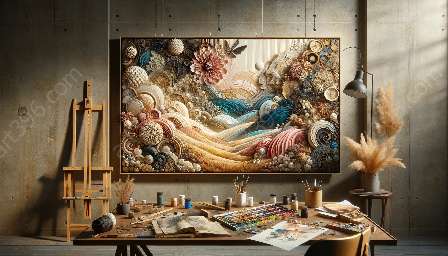Mixed media installation art represents a fascinating intersection of contemporary artistic expression and traditional creative techniques. This form of art incorporates a diverse range of materials, from everyday objects to advanced technologies, to create immersive and thought-provoking experiences for viewers. To truly appreciate the depth and complexity of mixed media installation art, it's essential to delve into its rich history and tradition.
Origins of Mixed Media Installation Art
The roots of mixed media art can be traced back to the early 20th century, when artists began experimenting with unconventional materials and spatial arrangements to challenge traditional notions of artistic practice. The concept of installation art, which involves the arrangement of objects in a specific space to create an artistic experience, emerged as a powerful vehicle for artistic expression.
As the boundaries of artistic expression expanded, mixed media installation art evolved as a form that embraces multiple disciplines, including sculpture, painting, video, sound, and performance art. This multidisciplinary approach allows artists to transcend the limitations of individual mediums and create dynamic, immersive environments that engage the senses and provoke emotional and intellectual responses.
Key Concepts in Mixed Media Installation Art
One of the defining characteristics of mixed media installation art is its emphasis on the relationship between art and space. Artists working in this medium often consider the unique characteristics of the exhibition environment, such as architectural elements, lighting, and spatial flow, to create site-specific installations that interact with and transform the surrounding space.
Furthermore, mixed media installation art frequently explores themes of temporality, ephemerality, and transformation. By incorporating perishable or transient materials, such as natural elements or found objects, artists are able to convey narratives of change, decay, and regeneration. This temporal dimension adds a layer of complexity to the viewer's experience, prompting reflection on the passage of time and the impermanence of artistic expression.
Influential Artists and Movements
The history of mixed media installation art is replete with visionary artists who have pushed the boundaries of traditional artistic practice and redefined the relationship between art and audience. From the pioneering works of artists like Marcel Duchamp, who challenged the notion of the readymade object, to contemporary practitioners such as Doris Salcedo, whose monumental installations address themes of memory and collective trauma, the evolution of mixed media installation art is closely intertwined with the innovative contributions of individual artists.
Several influential movements have also contributed to the development of mixed media installation art, including Fluxus, a radical interdisciplinary movement that emerged in the 1960s and emphasized the fusion of artistic mediums, and relational aesthetics, a concept introduced by curator and critic Nicolas Bourriaud that focuses on the social and interactive aspects of art within specific environments.
The Evolution of Mixed Media Installation Art
In the contemporary art world, mixed media installation art continues to thrive as artists explore new technologies, collaborative practices, and innovative approaches to engaging audiences. The advent of digital media and interactive technologies has expanded the possibilities for creating immersive and participatory installations, blurring the boundaries between the physical and virtual realms.
Furthermore, the global interconnectedness of the art world has enabled artists to draw inspiration from diverse cultural traditions and perspectives, enriching the visual and conceptual vocabulary of mixed media installation art. This ongoing evolution reflects the enduring relevance of this art form as a dynamic, responsive mode of creative expression that resonates with contemporary audiences.
Conclusion
Delving into the history and tradition of mixed media installation art provides a profound understanding of its roots, concepts, influential figures, and ongoing evolution. This art form serves as a testament to the enduring power of artistic experimentation and the capacity of visual expression to provoke introspection, dialogue, and transformation.

